Physical Address
304 North Cardinal St.
Dorchester Center, MA 02124
Make accurate distinctions between separate pathologic conditions in laboratory and clinical studies.
Provide a common descriptive tool for investigators who wish to present cases and describe the outcome of treatment programs.
The final diagnosis of knee ligament injuries is based on the specific anatomic defect derived from the abnormal motion limits and joint subluxations.
Ligaments have distinct mechanical functions to provide limits to tibiofemoral motions and the types of motions that occur between opposing cartilage surfaces.
Although there are six DOFs, manual stress examinations are designed to test just one or two limits at a time.
Ultimately, the clinical examination must be analyzed by a six-DOF system to detect abnormalities.
Together, the ligaments and joint geometry provide two limits (opposite directions) for each DOF.
Rotatory subluxations are characterized by the separate compartment translations that occur to the medial and lateral tibial plateaus during the clinical test.
The damage to each ligament and capsular structure is diagnosed using tests in which the primary and secondary ligament restraints have been experimentally determined.
Many different classification systems for knee ligament injuries have been proposed in the sports medicine literature. A series of studies we conducted enabled the development of an algorithm for the diagnosis and classification of these injuries based on kinematic and biomechanical data. The purpose of this chapter is to summarize these studies and provide the clinician with the proper examination techniques that allow precise diagnosis of abnormal knee motions, subluxations, and ligament injuries.
The purposes of a classification system are to (1) make accurate distinctions between separate pathologic conditions in laboratory and clinical studies and (2) provide a common descriptive tool for investigators who wish to present cases and describe the outcome of treatment programs. A system that allows two or more discrete types of injuries to be grouped as a single entity does not allow the association of a unique natural history or surgical result with the anatomic defect on the actual pathologic condition being treated.
The classification scheme developed from our investigations is based on seven concepts:
The final diagnosis of knee ligament injuries is based on the specific anatomic defect derived from the abnormal motion limits and joint subluxations.
Ligaments have distinct mechanical functions to provide limits to tibiofemoral motions and the types of motions that occur between opposing cartilage surfaces.
Although there are six degrees of freedom (DOF), the manual stress examinations are designed to test just one or two limits at a time.
Ultimately, the clinical examination must be analyzed by a six-DOF system to detect abnormalities.
Together, the ligaments and joint geometry provide two limits (opposite directions) for each DOF.
Rotatory subluxations are characterized by the separate compartment translations that occur to the medial and lateral tibial plateaus during the clinical test.
The damage to each ligament and capsular structure is diagnosed using tests in which the primary and secondary ligament restraints have been experimentally determined.
In this chapter, the studies presented related to the anterior cruciate ligament (ACL), posterior cruciate ligament (PCL), medial collateral ligament (MCL) and posteromedial structures, the iliotibial band (ITB), and the mid-lateral capsule. Studies related to the posterolateral structures (fibular collateral ligament [FCL], popliteus muscle-tendon ligament, and posterolateral capsule) are presented in Chapters 15 and 17 .
The term instability has been used to describe an abnormal motion or motion limit that exists to the joint because of a ligament injury. This term has also been used to indicate symptomatic giving-way of the knee joint that occurs during activity. Instead, it is recommended to describe the giving-way event and not use the term instability . Giving-way may be caused by many factors, including a ligament rupture, poor muscular control of the knee joint, altered neurologic function and control mechanisms, or mechanical problems such as a torn meniscus or loose body. In many cases, giving-way occurs because of multiple factors, and the term instability does not precisely indicate the exact cause of the episode. Rather than a diagnosis of anterior instability, it is more appropriate to reduce the abnormality to a precise anatomic diagnosis such as ACL rupture. In addition, other ligament deficiencies, if present, should be identified.
The term laxity simply indicates looseness and may be applied to increases in joint motion or increases in ligament elongation. Therefore, the term laxity does not provide a diagnosis of a specific abnormality. The knee has a normal amount of laxity (play or motion) required for function. An abnormal amount of laxity may occur as a result of a ligament disruption. Laxity may also indicate a ligament injury in which the ligament has an increase in length or elongation during loading. The finding of abnormal laxity represents a clinical sign that does not provide a precise diagnosis. Instead, the specific anatomic defect of the ruptured ACL and associated injured ligaments or capsular structures should be recorded as the diagnosis. The goal of a comprehensive knee examination is to detect an increase in the amount of motion (translation or rotation) or an abnormal position (subluxation) to determine the specific anatomic defects that are present.
Ligaments have distinct mechanical functions to provide limits to the amount of tibiofemoral motion that determines the types of motions occurring between opposing cartilage surfaces. The limits of motion are the main focus because loss of this function and the consequent subluxation are the underlying deficits in ligament-injured knees. In addition, the change in limits of motion is the primary basis of diagnosis.
The ability of ligaments to limit tibiofemoral motion provides the geometric parameters within which the neuromuscular system is able to control the position of the knee during activity. Although focus is placed on the mechanical function of the ligaments and capsular structures, the reader should be cognizant of the potentially important role of ligaments in providing sensory feedback to the neuromuscular system. Ligaments have three properties that affect their ability to limit joint motion: location of their attachment on the bones, just-taut length, and stiffness.
Tibiofemoral motions are limited along the line that connects the ligament's tibial and femoral attachments in the direction that loads the ligament. Ligaments are not able to limit motions perpendicular to their orientation or motions that cause them to become slack. Just-taut length is a determinant of joint laxity because it controls the amount of motion before the ligament begins to provide a resisting force. Because the two cruciate ligaments are required to limit anteroposterior (AP) translation, total AP translation is determined by the just-taut length of both ligaments.
Ligament stiffness controls how much additional joint movement is required after the ligament has become taut to create a force large enough for the ligament to resist the applied load. Decreased ligament stiffness produces an increase in the motion limit because a greater motion is required before the ligament can develop a sufficient restraining force.
The kinematic and biomechanical concepts required to interpret clinical tests are shown in Figure 3-1 . First, the appropriate clinical test must be selected to diagnose a specific ligament structural abnormality. Diagnostic information is obtained based on understanding the primary and secondary ligament restraint system. The results of the tests must be understood and communicated in terms of the six-DOF system that determines the abnormal motion limits. The medial and lateral tibiofemoral compartments are examined separately to determine the different types of subluxation. The final diagnosis of the ligament defect must be made in precise anatomic and functional terms and according to the severity of ligament failure (partial or complete).
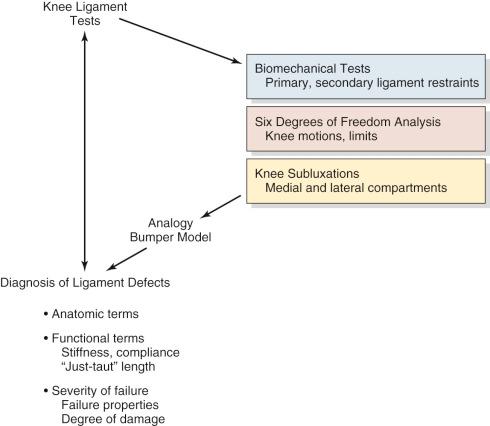
Although there are six DOF, the knee ligament examination is specifically designed to test just one or two motion limits at a time. Combinations of these motions (coupled motions) are particularly important to the diagnosis of knee ligament injury because they occur during many of the manual stress examinations.
Translation of a rigid body (such as the tibia) is described by the motion of an arbitrarily selected point on the body. Typically, the AP translation is described by the motion of a point located midway between the medial and lateral margins of the tibia. If only translation motions occur, the amount of motion does not depend on which point is chosen—that is, whether the point is at the center of the knee or at the medial or lateral joint margin. This is because all points will move along parallel paths. However, when rotation and translation motions are combined, the amount of translation does depend on which point is used. This can be seen by considering the four cases illustrated in Figure 3-2 .
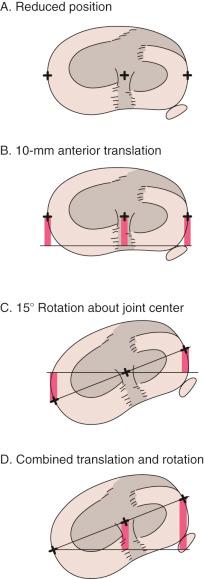
Figure 3-2, B shows an anterior translation of 10 mm without associated tibial rotation. All points move anteriorly by the same amount. Figure 3-2, C shows an internal rotation of 15 degrees about an axis located midway between the spines of the intercondylar eminence. The point on the rotation axis is stationary while the lateral joint margin (edge) moves anteriorly and the medial margin posteriorly (see Fig. 3-2, D ). The amount of anterior and posterior motion of the points at the joint margin depends on the amount of rotation and how far they are away from the rotation axis (center of rotation). This illustrates that when translation is measured in the presence of a concurrent rotation, it is important to know at which point the translation was measured.
The clinician who understands all of the possible motions in the knee joint that are normally limited by the knee ligaments will be able to perform manual stress tests and correctly determine the specific abnormality that is present. However, a diagnosis cannot be based solely on the abnormal motions detected. The diagnosis also requires knowledge of the biomechanical data regarding which ligaments limit each of the possible motions in the knee joint.
The field of science that describes the motions between objects is known as kinematics . A fundamental aspect of this field is the recognition that six possible motions may occur in three dimensions. Each of the six motions is discrete and separate from the other five motions. The six motions are referred to as degrees of freedom . The three rotational DOF in the knee joint are shown in Figure 3-3 . Each rotation occurs about one axis: flexion-extension, internal-external, and abduction-adduction.
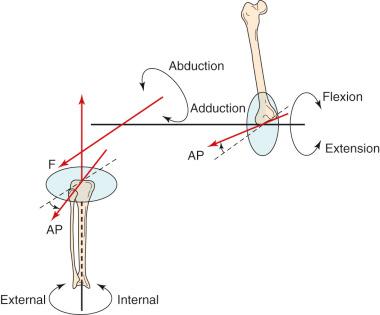
The flexion-extension axis is located in the femur and oriented in a pure medial-lateral direction perpendicular to the femoral sagittal plane. Rotation of the tibia about this axis does not have associated internal-external rotation or abduction-adduction motions. Because these motions occur during flexion, the flexion-extension axis shown in Figure 3-3 does not correspond to the functional flexion axis. The functional flexion axis is skewed in the knee and changes its orientation as the knee is flexed. This skewed orientation accounts for the combined motions of flexion, abduction, and tibial rotation.
The internal-external tibial rotation axis is located in the tibia, parallel to the tibial shaft and perpendicular to the tibial transverse plane. Rotations about this axis are pure internal and external tibial rotation motions without any associated abduction-adduction or flexion-extension.
The abduction-adduction rotation axis is more difficult to visualize because it is not located in either bone and its orientation can change relative to both. This axis is always parallel to the femoral sagittal plane. When the knee is flexed, the orientation of the abduction axis changes relative to the femur as it rotates in the sagittal plane. The abduction axis is perpendicular to the tibial rotation axis and parallel to the tibial transverse plane.
There are three linear DOF in the knee joint, referred to as translations . One simple approach to describing translations is to visualize relative sliding between the bones along each of the three rotational axes ( Fig. 3-4 ). The sliding motion along the flexion-extension axis is the medial-lateral translation between the tibia and femur. The sliding motion along the tibial rotation axis results in joint compression and distraction translation. Sliding motions along the abduction-adduction rotation axis produce AP translations. These are also commonly known as drawer motions .
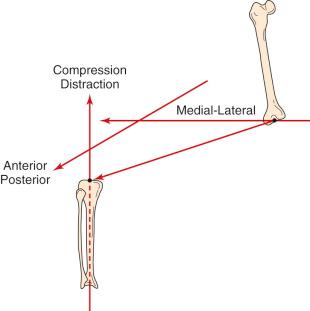
Therefore, there are six possible motions that can occur in the knee: three rotations and three translations. Three axes are required to explain these six motions, one fixed in each bone (see Fig. 3-4 ). Each axis represents two DOF, one a rotation occurring about the axis and the other a translation.
The purpose of the examination is to determine the specific increase in motion (amount and direction) of each clinically relevant DOF. In many cases, coupled motions occur in the knee joint, such as anterior translation combined with internal tibial rotation during Lachman testing, which is further increased on pivot shift testing. First, the examiner must understand the effect that ligament defects have on each of these motions, because one or both may be increased. Second, both the amount of increased motion and resulting subluxation of the tibial plateaus depend on the position of the knee joint, which is defined in terms of six DOF. Third, after a ligament is ruptured, an abnormal position usually is present in the axis of internal-external tibial rotation. This may be detected on examination and is helpful in diagnosing the ligament defect.
To understand the results of the clinical examination, a distinction must be made between abnormalities in joint motion and abnormalities in joint position (subluxation) that occur at the limit of the test. An abnormality in one or more motion limits can cause a subluxation of the knee joint. The subluxation depends on the direction and magnitude of the loads applied. Clinical tests are used to detect the motion limit and the final abnormal joint position. The examination usually detects a subluxation and not a complete knee dislocation, in which contact of the articulating surfaces of both tibiofemoral compartments is lost.
Together, the ligaments and joint geometry provide two limits (opposite directions) for each DOF. Altogether, there are 12 possible limits of motion of the knee ( Table 3-1 ). Injury to the structures that limit each motion increases joint laxity. The position of the joint at the final limits of motions (reflecting the ligament attachment sites) provides the information required for diagnosis. From a diagnostic standpoint, it would be ideal if each of the 12 limits of motion were controlled by a single ligamentous structure. Differential diagnosis could then be performed by evaluating each of the 12 limits separately. Clearly, this ideal situation does not exist. The ligaments, capsular structures, and joint geometry all work together and each contributes to limiting more than one motion. Thus, the problem of diagnosing knee injuries reduces to determining how to apply individual or combination motions to lengthen primarily a single ligament or capsular structure so that structure can be evaluated independently.
| Motion Limit | Structures Limiting the Motion |
|---|---|
| Flexion | Ligaments, leg and thigh shape, joint compression |
| Extension | Ligaments and joint compression |
| Abduction | Ligaments and lateral joint compression |
| Adduction | Ligaments and medial joint compression |
| Internal rotation | Ligaments and menisci |
| External rotation | Ligaments and menisci |
| Medial translation | Bones (spines interlocking with femoral condyles) and ligaments (to prevent distraction) |
| Lateral translation | Bones (spines interlocking with femoral condyles) and ligaments (to prevent distraction) |
| Anterior translation * | Ligaments |
| Posterior translation * | Ligaments |
| Joint distraction | Ligaments |
| Joint compression | Bone, menisci, and cartilage |
* Menisci, joint compressive effects after injury to primary restraint.
The ability to isolate each structure is the key to differential diagnosis of individual ligament injuries. The isolation of a structure is accomplished by placing the knee at the proper joint position (specifically, knee flexion angle and tibial rotation position) before the clinical stress test is performed. For example, the abduction (valgus) stress test is performed both in full extension and at 20 to 30 degrees of flexion. In the flexed position, the posterior capsule becomes slack, which allows the examiner to primarily load the MCL and mid medial capsule. The evaluation of ACL function is performed at 20 degrees of knee flexion as opposed to the 90-degree position commonly used many years ago; the 20-degree position more often results in increased anterior subluxation because secondary restraints are more slack and less able to block this motion. Diagnosis of an injury to a specific ligament is performed at a joint position at which other structures are the most lax and least able to block the abnormal subluxation from the ligament injury. The lax secondary restraints allow an increase in joint motion before they become taut and resist further joint motion. Thus, isolating a ligament so its integrity may be individually tested requires placing the knee in a position in which other supporting structures are slack.
Another example of the importance of selecting the joint position for clinical tests is the diagnosis of PCL injury. Figure 3-5 shows the amount of increased posterior tibial translation that occurs when the PCL is removed. The increase in posterior translation is two to three times greater at 90 degrees of flexion than at 20 degrees of flexion. This phenomenon is easily understood using a bumper model analogy in which the amount of joint motion after a ligament is injured depends on the role and function of the remaining ligaments that must ultimately limit the joint motion ( Fig. 3-6 ). Thus, the increase in joint motion that occurs when a ligament is injured reflects the amount of additional joint motion required before the remaining intact ligaments become stretched and are able to limit further motion.
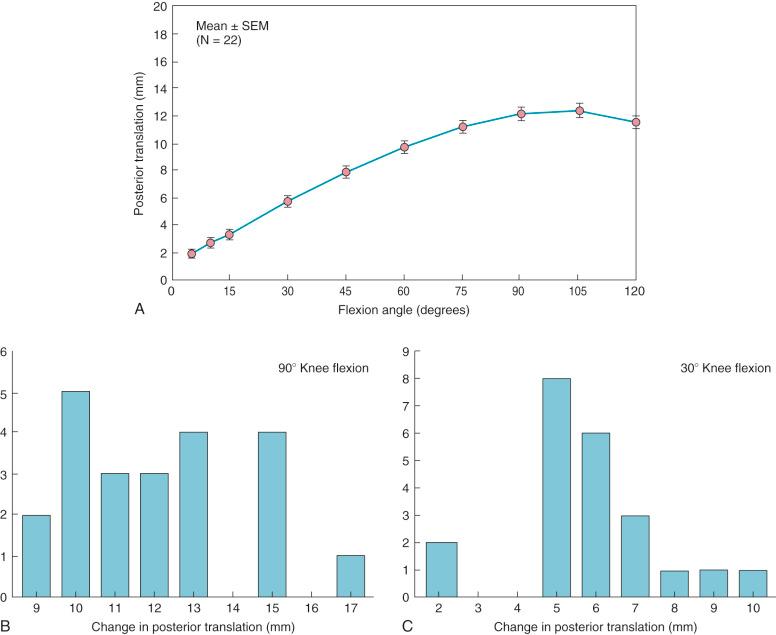
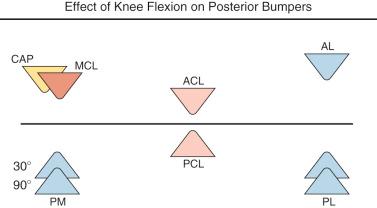
Figure 3-7 illustrates the limits to internal tibial rotation in the knee joint. At 30 degrees of flexion (see Fig. 3-7, A ), the limits to internal rotation are provided by posteromedial structures, lateral structures, and the ACL all working together. Sectioning either the ACL or the lateral structures produces a small increase in internal rotation. When both of these structures are cut together, a larger increase in internal rotation occurs. The further limit to internal rotation is the FCL, based on its anatomy.
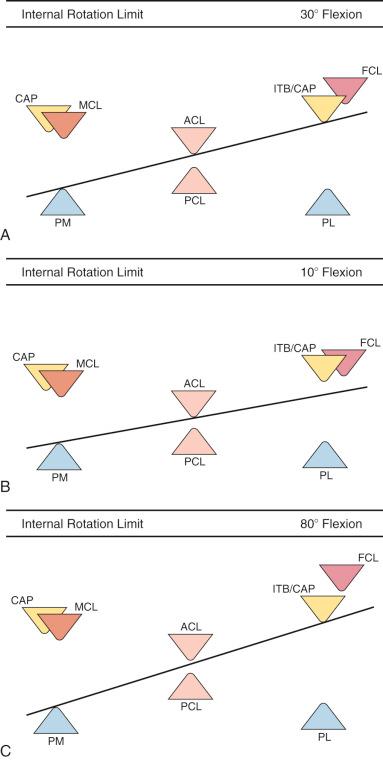
The ACL dominates at flexion angles less than 30 degrees, whereas the lateral structures dominate at flexion angles greater than 30 degrees. This can be explained by considering the changes that occur in ligament slackness with flexion and extension. As the knee is extended past 20 degrees, the amount of AP translation decreases owing to reduction in the combined slackness of both cruciate ligaments. This brings these bumpers closer together. The posteromedial capsule (PMC) also tightens, moving its bumper anteriorly. This combination (see Fig. 3-7, B ) results in a decreased role of the anterolateral structures because the tibia can no longer rotate to the point where it becomes taut.
With flexion beyond 30 degrees, the lateral structures become progressively tighter and the posteromedial structures become progressively slack. This combination causes internal rotation to be limited first by the extraarticular restraints, and is consistent with laboratory results showing that sectioning the ACL alone does not increase internal rotation when the knee is flexed between 40 and 80 degrees.
Figure 3-8 illustrates the limits to external rotation. At 30 degrees of flexion, external rotation is limited only by the extraarticular restraints. On the lateral side, this includes all of the posterolateral structures, which act as a unit. Large increases in rotation do not occur until all structures are cut. At 90 degrees of flexion, the posterior capsule is slack and the PCL blocks significant increases in external rotation when the posterolateral structures are sectioned. In laboratory studies, external rotation increases an average of only 5.3 ± 2.6 degrees when all of the posterolateral structures are sectioned and the PCL is intact. When the PCL is also sectioned, a large additional increase in external rotation occurs, ranging from 15 to 20 degrees.
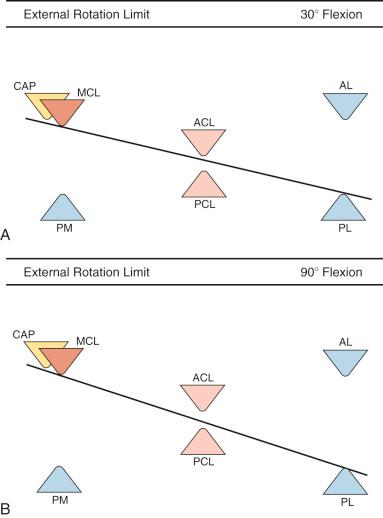
An example of the changes in motion limits in ACL ruptures is shown in Figure 3-9 . In cadaver knees, cutting the ACL causes an abnormal increase in both anterior tibial translation and internal tibial rotation. The increase in anterior tibial translation is the primary abnormality, because it increases 100% while there is a small increase in internal rotation (approximately 15%). Cutting the ACL alone produced a small but significant increase in internal rotation, greatest at 0 and 15 degrees ( Fig. 3-10 ). Subsequently, sectioning the ITB and lateral capsule produced statistically significant increases at 30 degrees and greater.
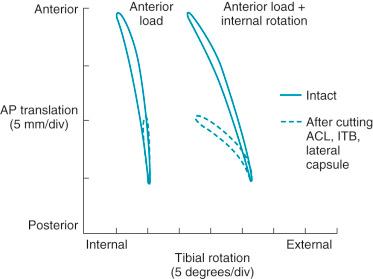
![FIG 3-10, Limits of internal rotation with 5 N-m moment for intact specimens and with the anterior cruciate ligament (ACL), ACL/anterolateral structures (ALS), fibular collateral ligament (FCL), and anterolateral ligament (ALL) structures (ACL/ALS/FCL/posterolateral structures [PLS]) cut. Increases in internal rotation with the ACL cut are all statistically significant, but the magnitude of these increases is so small that they are clinically unimportant. With ACL/ALS sectioning, increases in internal rotation are statistically significant at 30 degrees of flexion and above. Statistically significant increases are found at 15 degrees of flexion and above in the ACL/ALS, FCL cut state, and at all flexion angles of the ALL cut state. The effect of the PLS on restraining internal rotation in the extended knee can be seen by comparing the ACL/ALS/FCL curve and the ALL cut curve. The difference between these curves reflects sectioning the PLS. The largest differences are found at 15 and 30 degrees of flexion. FIG 3-10, Limits of internal rotation with 5 N-m moment for intact specimens and with the anterior cruciate ligament (ACL), ACL/anterolateral structures (ALS), fibular collateral ligament (FCL), and anterolateral ligament (ALL) structures (ACL/ALS/FCL/posterolateral structures [PLS]) cut. Increases in internal rotation with the ACL cut are all statistically significant, but the magnitude of these increases is so small that they are clinically unimportant. With ACL/ALS sectioning, increases in internal rotation are statistically significant at 30 degrees of flexion and above. Statistically significant increases are found at 15 degrees of flexion and above in the ACL/ALS, FCL cut state, and at all flexion angles of the ALL cut state. The effect of the PLS on restraining internal rotation in the extended knee can be seen by comparing the ACL/ALS/FCL curve and the ALL cut curve. The difference between these curves reflects sectioning the PLS. The largest differences are found at 15 and 30 degrees of flexion.](https://storage.googleapis.com/dl.dentistrykey.com/clinical/ScientificBasisforExaminationandClassificationofKneeLigamentInjuries/9_3s20B9780323329033000032.jpg)
Coupled motions (anterior tibial translation, internal tibial rotation) occur in cadaver knees after sectioning the ACL and lateral extraarticular structures. Coupled motions can be caused by factors intrinsic to the knee or by the manner in which the clinical test is performed. For instance, the amount of internal tibial rotation elicited depends on the amount of rotation the clinician applies during the examination. This is why it is difficult to obtain reproducible results with the Lachman and other clinical tests. The KT-2000 (MEDmetric) provides an objective measurement of the amount of tibial translation measured at the center of the tibia. However, the millimeters produced by this device do not include the added millimeters of translation at the lateral tibiofemoral joint with added internal tibial rotation, such as that produced during the pivot shift test.
The amount of anterior tibial translation induced during anterior drawer testing is dependent on the amount of internal or external tibial rotation applied at the beginning of the test ( Fig. 3-11 ). The instrumented knee joint is shown for measuring rotations and translation motions during the clinical examination in Figure 3-12 . This is because rotation tightens the extraarticular secondary restraints. The greatest amount of anterior or posterior tibial translation will be produced when the tibia is not forcibly rotated internally or externally, tightening extraarticular structures, during the clinical test. If the tibia is internally or externally rotated before the start of testing, the amount of tibial translation elicited will be smaller. Thus the clinician controls the amount of translation by both the initial rotational position of the tibia and by the amount of rotation imposed during the test. There is considerable variation in examination techniques of clinicians that makes all of the clinical tests highly subjective and qualitative, as is discussed.
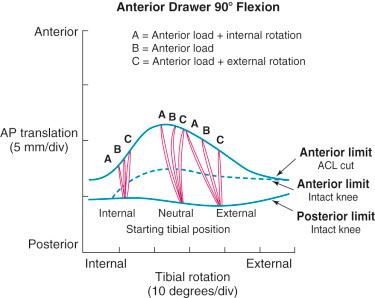
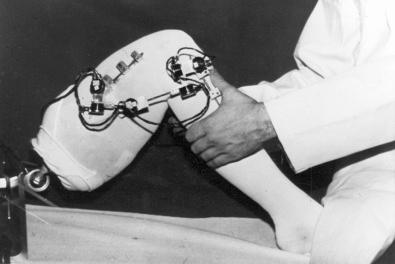
The pivot shift and flexion-rotation drawer tests involve a complex set of tibial rotations and AP translations ( Fig. 3-13 ). At the beginning of the flexion-rotation drawer test, the lower extremity is simply supported against gravity ( Fig. 3-14 , position A). After ligament sectioning, both anterior tibial translation and internal rotation increase as the femur drops back and externally rotates into a subluxated position. This position is accentuated as the tibia is lifted anteriorly ( Fig. 3-14 , position B). At approximately 30 degrees of flexion, the tibia is pushed posteriorly, reducing the tibia into a normal relationship with the femur ( Fig. 3-14 , position C). This is the limit of posterior tibial translation resisted primarily by the PCL. From position C to position A, the knee is extended to produce the subluxated position again.
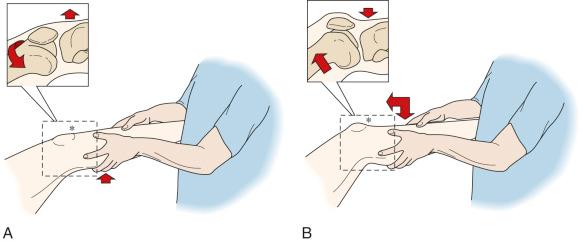
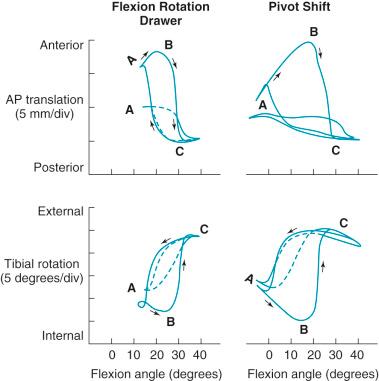
The rotational component of the test can be purposely accentuated by the examiner, inducing a rolling motion of the femur. One advantage of the flexion-rotation drawer test is that it is not necessary to produce joint compression or add a lateral abduction force required in the pivot shift test. The rolling motion avoids the sometimes painful “thud/clunk” phenomenon induced in the pivot shift test. A finger may also be placed along the anterior aspect of the lateral and medial plateau and the tibiofemoral step-off palpated to provide a qualitative estimate of the millimeters of anterior tibial subluxation. The examiner can easily visualize the translation and rotation motions. Translation is observed by watching the forward motion of the tibial plateaus. Rotation is observed by watching the patella rotate externally with the femur in the subluxated position and internally in the reduced position.
The pivot shift and flexion-rotation drawer tests are graded only in qualitative terms because it is not possible to determine accurately the actual amount of internal tibial rotation or anterior translation elicited. A fully positive pivot shift test (grade III) indicates a gross subluxation of the lateral tibiofemoral articulation along with an increased anterior displacement of the medial tibial plateau ( Table 3-2 ). The amount of anterior subluxation elicited is indicative of rupture to the ACL and laxity to the secondary extraarticular restraints. The lateral tibial plateau demonstrates the greater subluxation in a positive pivot shift test, indicating that the lateral restraints (ITB, lateral capsule) are not functionally tight. This does not mean that these restraints are injured because a physiologic slackness of the ITB tibiofemoral attachments is normal at the knee flexion position used in this test. These attachments are tightest at knee flexion angles 45 degrees and higher. Therefore the majority of knees with an isolated ACL tear will have a positive pivot shift phenomenon.
| STRUCTURES INVOLVED | |||||
|---|---|---|---|---|---|
| Test Grade | Anterior Cruciate Ligament | Iliotibial Band, Lateral Capsule | Medial Ligaments, Capsule | Positive Tests | Comments |
| Normal | Intact | Intact | Intact | ||
| I | Intact to slight increase in laxity | Intact | Intact | Lachman, flexion-rotation drawer, pivot shift “slip” but not “jerk” | Either physiologic laxity or partial ACL laxity allow subtle subluxation-reduction phenomena. Secondary ligament restraints limit the amount of joint subluxation. Subluxation is detected as a “slip,” indicating increased lateral compartment translation. |
| II | Ruptured | Intact to slight increase in laxity | Intact | All tests | Hallmark is an obvious “jump,” “thud,” or “jerk” with the gross subluxation-reduction during the test. There is either a normal physiologic laxity (lateral capsule, iliotibial band) or injured secondary restraints. |
| III | Ruptured | Significant increase in laxity | May have increase in laxity | All tests | Hallmark is a gross subluxation with impingement of the posterior aspect of the lateral tibial plateau against the femoral condyle. The examiner must decrease internal rotational torque on the leg to allow lateral tibiofemoral reduction and further knee flexion. |
In knees with a grade III pivot shift, the amount of anterior tibial subluxation is so great that the posterior margin of the lateral tibial plateau impinges against the lateral femoral condyle and blocks further knee flexion during the test. The examiner must add both a maximal anterior force and internal tibial rotation force to determine whether the maximum subluxation position can be reached. In revision ACL reconstructions, a combined intraarticular graft and extraarticular ITB surgical approach is often considered.
In a small percentage of knees with ACL ruptures, the classic “thud” or “clunk” will not be elicited during the pivot shift test. An experienced examiner will detect an increased slipping sensation in the knee (grade I), which indicates that the extraarticular secondary restraints are physiologically tight, limiting the amount of anterior tibial subluxation, or that a partial ACL tear exists.
A simple concept may assist in explaining the abnormal motions that occur after ACL rupture: rotatory subluxations can be classified according to the amount of anterior and posterior translation of each tibiofemoral compartment. Figure 3-15, A shows a Lachman test performed on a knee in which the combined motions of anterior tibial translation and internal tibial rotation occur about a medially located rotation axis. In this example, only planar motion occurs; the ACL rupture doubles the amount of anterior tibial translation and slightly increases internal tibial rotation. The rotation axis shifts medially. The ratio of tibial translation to degrees of internal tibial rotation determines how far medially the axis of rotation shifts.
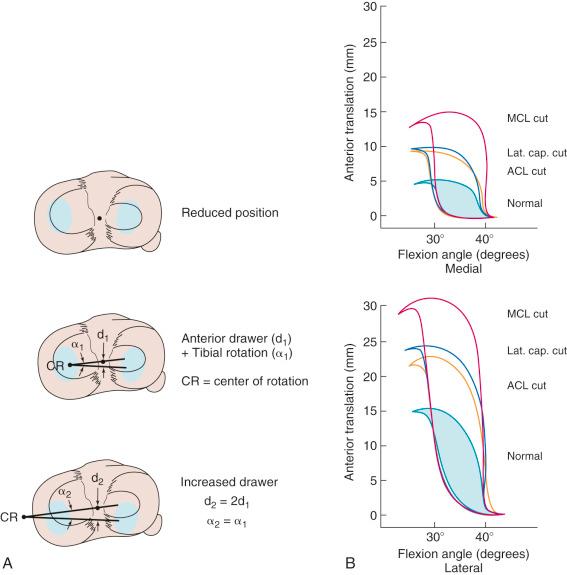
The abnormalities in tibial rotation and translation are easily expressed in terms of the different amounts of anterior translation that occur to the medial and lateral compartments (see Fig. 3-15, B ) in biomechanical tests. During the clinical tests, the clinician may qualitatively palpate and observe the anterior or posterior translation of each tibial plateau. The AP translation of each plateau is characterized instead of defining the individual components of translation, rotation, and rotation axis location that all lead to the anterior subluxation. The combined effect of the rotation and translation determines the translation of the medial and lateral tibiofemoral compartments.
The type of rotatory subluxations that occur depends on both the ligament injury and the knee flexion position. The subluxations of the medial and lateral compartment are usually recorded at two knee flexion positions, such as 20 and 90 degrees. Described later is the dial test for posterolateral injuries, in which the examiner determines whether increases in external tibial rotation reflect anteromedial or posterolateral tibial subluxations. It should be noted that rotatory subluxations are historically based on increases in tibial internal or external rotation, and only in a few studies have the actual medial and lateral tibial subluxations in an AP direction been determined. There are complex rotatory subluxations involving increases in translation, but in opposite directions of both the medial and lateral compartments with combined medial and lateral ligament injuries.
There have been numerous in vitro and in vivo studies published over the past decade on ACL function in regard to providing rotational knee stability. Based on the results of these studies, recommendations for ACL single- and double-bundle graft reconstructions, graft placement, and tensioning have been published. These investigations involved a simulated Lachman test and, more importantly, the pivot shift test, which correlates with patient-subjective giving-way symptoms. In our opinion, there are problematic errors in many studies of which the surgeon should be aware in terms of application of the results to surgical treatment of ACL ruptures. For example, nearly all published studies describe rotational knee stability according to the changes in degrees of internal tibial rotation without measuring the center of tibial rotation or the position or subluxation of the tibiofemoral compartments. We believe that providing only the changes in degrees of tibial rotation, without specification of the medial and lateral tibiofemoral compartment position or subluxation, is an inadequate descriptor of rotational knee stability. In fact, after ACL rupture, there is a change of only a few degrees of internal tibial rotation as long as the lateral extraarticular structures remain intact.
A second problem we have identified in a majority of in vivo and in vitro pivot shift studies is the loading profile used to induce anterior tibial subluxation. Studies commonly report, in the pivot shift simulation, an abnormal anterior tibial translation after ACL sectioning that is only half that obtained in the Lachman test. However, under clinical conditions, a positive pivot shift test produces greater anterior tibial subluxation than the Lachman test. Accordingly, these prior studies were conducted under low knee displacement conditions in which the loading profile involved an internal rotation-valgus condition during knee extension to produce anterior tibial subluxation. There was an absence of a simultaneous combined anterior tibial loading, which is important in the clinical pivot shift test to induce anterior tibial subluxation of both the lateral and medial tibiofemoral compartments.
Bedi and colleagues reported (from in vitro and in vivo pivot shift studies) that the magnitude of lateral compartment translation showed a correlation with the clinical grade of the pivot shift and that a threshold of 6 to 7 mm was necessary to produce a positive pivot shift. This study measured both lateral and medial compartment translations. The mechanized pivot shift involved only small increases in medial tibiofemoral compartment translations, reflecting an internal rotation torque in the absence of anterior tibial loading. ACL sectioning failed to produce a positive pivot shift (grade II) in nearly all specimens, which limits interpretation of these data.
For reasons not apparent, pivot shift loading with a predominant internal rotation-valgus torque, without a coupled anterior tibial loading, has been the typical loading profile in nearly all cadaveric studies on ACL function and surgical reconstructions even though this limits anterior tibial subluxation of the medial compartment. In Figure 3-16 , the results of a typical cadaveric knee specimen are shown under two pivot shift loading conditions. Two points are important. In the two simulated pivot shift tests, there is a greater anterior tibial subluxation of the lateral and medial compartment, with the pivot shift subluxation produced by a coupled anterior translation–internal rotation during the valgus loading (pivot shift [PS] 4), compared with an absence of the anterior tibial loading component (PS 3). Second, an analysis of rotational knee stability requires knowledge of the resulting subluxations (translations) of the medial and lateral tibiofemoral compartments. We recommend that future in vitro and in vivo pivot shift studies use loading profiles of coupled anterior tibial translation and internal tibial rotation, along with valgus loading, to induce a maximum anterior tibial subluxation of both tibiofemoral compartments. Furthermore, rotational torques should remain low in order not to constrain the maximum subluxation of the medial compartment.
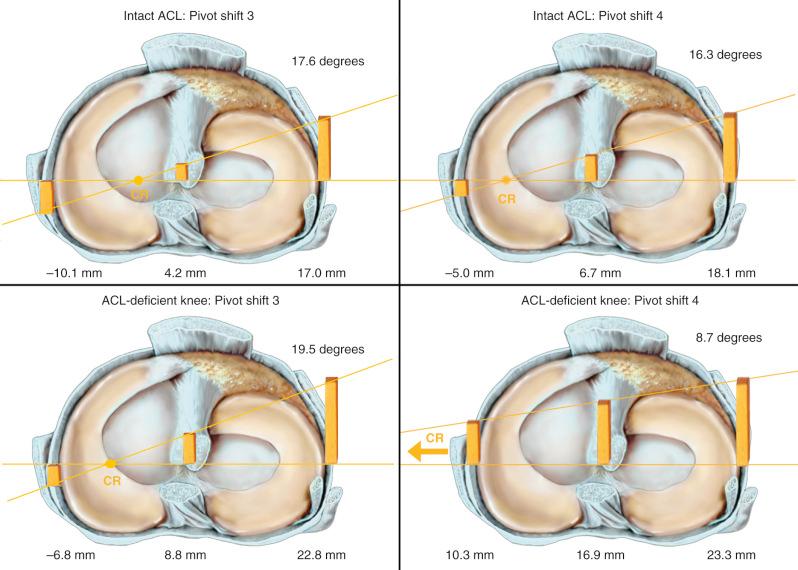
We conducted a series of robotic cadaveric in vitro studies on the kinematic function of the ACL. The studies involved a six-DOF robotic testing protocol on intact knees, ACL-sectioned knees, and ACL-reconstructed knees. The robotic testing protocol involved, for the first time, the simulation of the pivot shift event using four DOF—namely, anterior tibial translation with internal tibial rotation with valgus loading of the limb during knee flexion-extension to induce maximum anterior tibial subluxation (PS 4). The study also involved, for the first time, digitization of the tibial plateau to determine medial and lateral tibiofemoral compartment translations and centers of tibial rotation in the simulated pivot shift test.
The studies that found a single ACL graft placed into the anatomic center of the femoral and tibial attachment sites restored normal tibiofemoral compartment translations and rotations under simulated Lachman and pivot shift testing conditions. The reconstruction restored rotational stability as defined by normal motion limits and normal medial and lateral compartment translations under simulated pivot shift loading conditions ( Fig. 3-17 ). The results support the recommendation for the use of a single ACL graft instead of a double-bundle ACL graft construct (see Chapter 7 ).
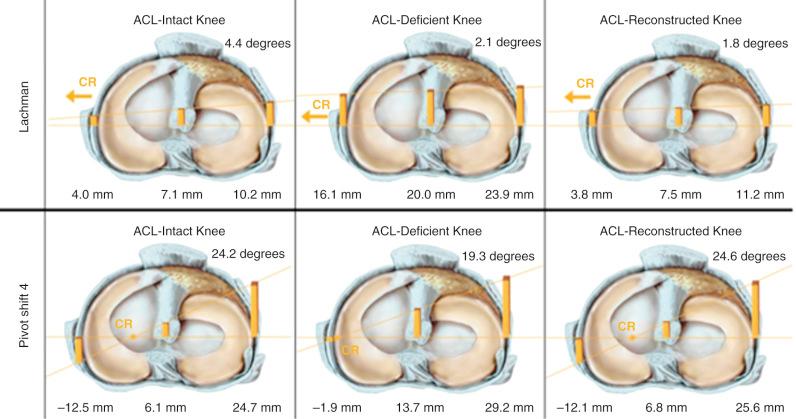
Become a Clinical Tree membership for Full access and enjoy Unlimited articles
If you are a member. Log in here